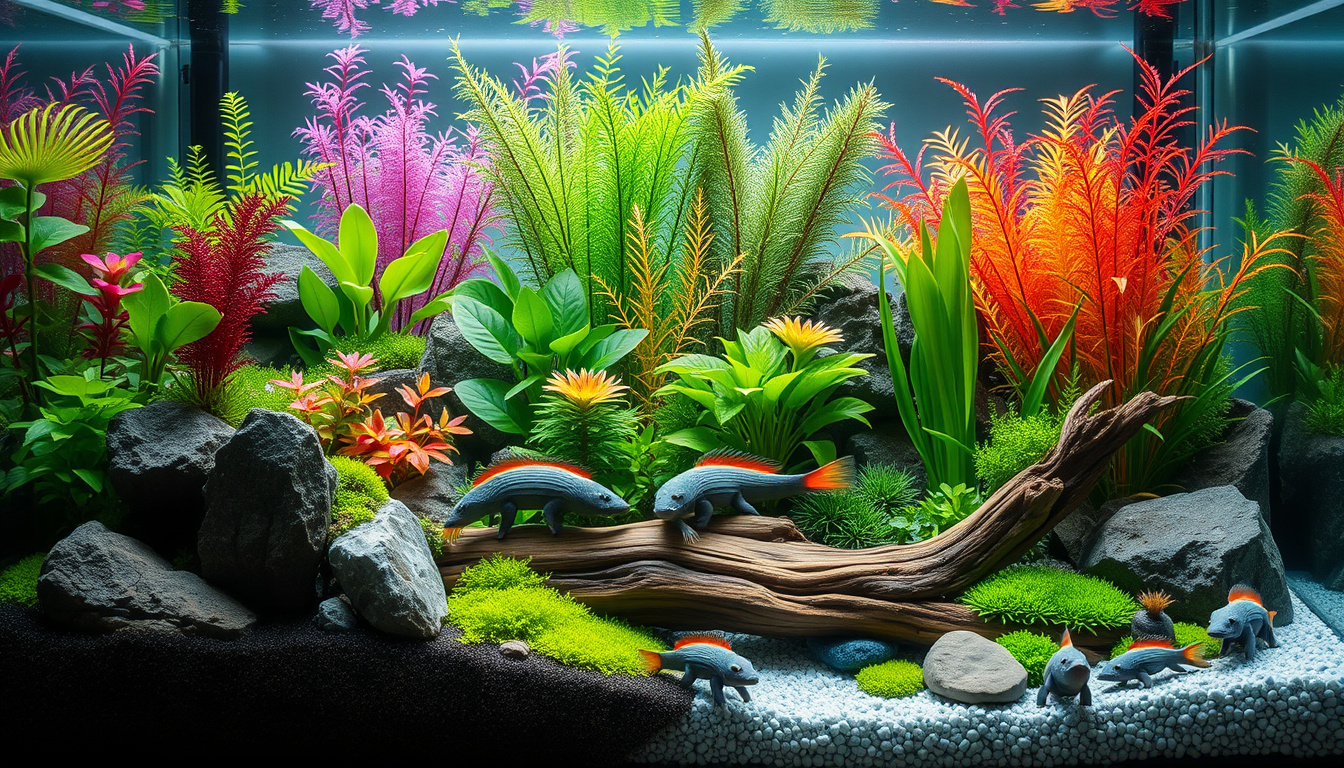If you’re a fan of unique and adorable pets, you’ve probably heard of the axolotl – those fascinating little creatures that look like they just stepped out of a cartoon.
But did you know that axolotls thrive best in a carefully crafted underwater environment?
That’s where the art of axolotl aquascaping comes in.
In this guide, we’ll dive into everything you need to know about creating the perfect habitat for your axolotls, ensuring they not only survive but truly thrive in your care.
Get ready to learn about their specific needs, essential elements for a stunning aquascape, plant selection, water quality, and tips to keep that ecosystem balanced.
Let’s make your axolotl’s home a vibrant, healthy paradise!


Choosing the Right Plants and Substrate
When diving into the fascinating world of axolotl aquascaping, selecting the right plants and substrate is crucial for creating a thriving environment for your unique aquatic pets.
Axolotls, with their delicate skin and gills, thrive best in setups that mimic their natural habitat.
Start by choosing soft, live plants like Java moss, anubias, or hornwort, which not only provide shelter and hiding spots for your axolotl but also help in maintaining water quality by absorbing excess nutrients.
For substrate, opt for sand or a smooth gravel; these are gentle on your axolotl’s sensitive skin and reduce the risk of injury.
Avoid sharp-edged substrates, as they could injure your little friend while they explore their space.
When paired thoughtfully, your substrate and plants will create a balanced ecosystem, ensuring your axolotl remains healthy and happy, while also making your aquarium visually stunning.
Maintaining Water Quality and Temperature
When it comes to axolotl aquascaping, maintaining water quality and temperature is crucial for the health and happiness of these unique aquatic creatures.
Axolotls thrive in clean, fresh water that is kept at a cool temperature, ideally between 60-68°F (16-20°C).
To achieve this, consider investing in a reliable filtration system to prevent toxins from building up in the tank.
Additionally, regular water changes are necessary to ensure optimal conditions; aim for about 20% of the water to be replaced weekly.
It’s important to use a water conditioner to eliminate harmful chemicals, like chlorine, which can be detrimental to your axolotl’s health.
When scaping your tank, also think about incorporating live plants that can help improve water quality by absorbing excess nitrates, while also creating a natural habitat for your axolotl.
Keeping a close eye on the water parameters, such as pH and ammonia levels, will further enhance your axolotl’s environment, making it not only beautiful but also safe and comfortable.
Frequently Asked Questions
What are the basic needs of axolotls for a successful aquascape?
Axolotls need a spacious tank with clean, chilled water, ample hiding spots, and appropriate substrates to prevent them from swallowing harmful materials.
They also require stable water parameters with a pH between 6.5 and 7.5, a temperature range of 60-68°F, and gentle filtration.
Can I use any type of substrate for my axolotl tank?
It’s best to avoid gravel or small substrates that axolotls might ingest.
Instead, use sand or bare-bottom tanks to prevent impaction, as axolotls are prone to ingesting substrates when foraging.
What types of plants are suitable for axolotl aquascaping?
Choose soft-leaved plants like Java fern, Anubias, and hornwort, which can provide shade and hiding spots without sharp edges that could harm your axolotl.
Avoid any plants with toxic properties.
How can I maintain water quality in an axolotl tank?
Regularly test the water parameters using a reliable kit, perform weekly water changes (about 20-30%), and ensure that your filtration system is adequate without creating strong currents, as axolotls prefer calm waters.
What tips can I follow to create a balanced ecosystem for my axolotls?
Introduce a variety of live plants, maintain a consistent feeding schedule, monitor water conditions closely, and avoid overstocking the tank.
Additionally, incorporate decorations that mimic their natural habitat to enhance their environment.
[center][/center]
[center][color=rgb(10, 10, 10)][highlight=rgb(255, 248, 231)] [/highlight][/color][color=rgb(10, 10, 10)][highlight=rgb(255, 248, 231)]As an Amazon Affiliate,[/highlight][/color][color=rgb(10, 10, 10)][highlight=rgb(255, 248, 231)] [/highlight][/color][color=rgb(10, 10, 10)][highlight=rgb(255, 248, 231)]Savvy Keto makes a commission[/highlight][/color][color=rgb(10, 10, 10)][highlight=rgb(255, 248, 231)] [/highlight][/color][color=rgb(10, 10, 10)][highlight=rgb(255, 248, 231)](at no extra cost to you)[/highlight][/color][color=rgb(10, 10, 10)][highlight=rgb(255, 248, 231)] [/highlight][/color][color=rgb(10, 10, 10)][highlight=rgb(255, 248, 231)]on purchases you make[/highlight][/color][color=rgb(10, 10, 10)][highlight=rgb(255, 248, 231)] [/highlight][/color][color=rgb(10, 10, 10)][highlight=rgb(255, 248, 231)]thru links on this site.[/highlight][/color][/center]

